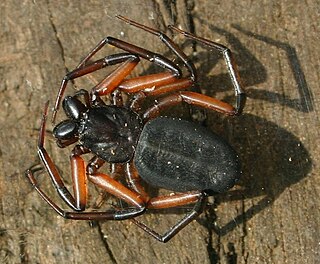
Theridiidae, also known as the tangle-web spiders, cobweb spiders and comb-footed spiders, is a large family of araneomorph spiders first described by Carl Jakob Sundevall in 1833. This diverse, globally distributed family includes over 3,000 species in 124 genera, and is the most common arthropod found in human dwellings throughout the world.

Linyphiidae, spiders commonly known as sheet weavers, or money spiders is a family of very small spiders comprising 4706 described species in 620 genera worldwide. This makes Linyphiidae the second largest family of spiders after the Salticidae. The family is poorly understood due to their small body size and wide distribution; new genera and species are still being discovered throughout the world. The newest such genus is Himalafurca from Nepal, formally described in April 2021 by Tanasevitch. Since it is so difficult to identify such tiny spiders, there are regular changes in taxonomy as species are combined or divided.

Trochanteriidae is a family of spiders first described by Ferdinand Karsch in 1879 containing about 52 species in 6 genera. Most are endemic to Australia though Doliomalus and Trochanteria are from South America and Plator is from Asia. Platyoides species exist in southern and eastern Africa, Madagascar, and the Canary Islands with one species, P. walteri, introduced to Australia.
Synaphridae is a family of spiders with thirteen described species in three genera. It was first described as a subfamily of Anapidae, but it has since been raised to family status.

Archaeidae, also known as assassin spiders and pelican spiders, is a spider family with about ninety described species in five genera. It contains small spiders, ranging from 2 to 8 millimetres long, that prey exclusively on other spiders. They are unusual in that they have "necks", ranging from long and slender to short and thick. The name "pelican spider" refers to these elongated jaws and necks used to catch their prey. Living species of Archaeidae occur in South Africa, Madagascar and Australia, with the sister family Mecysmaucheniidae occurring in southern South America and New Zealand.
Spermophorides is a genus of cellar spiders that was first described by J. Wunderlich in 1992.
Acartauchenius is a genus of dwarf spiders that was first described by Eugène Louis Simon in 1884.
Dippenaaria is a genus of African araneomorph spiders in the family Anapidae, containing the single species, Dippenaaria luxurians. It was first described by J. Wunderlich in 1995, and has only been found in South Africa. The genus was named in honour of South African arachnologist Ansie Dippenaar-Schoeman.
Penangodyna is a monotypic genus of Southeast Asian cribellate araneomorph spiders in the family Dictynidae containing the single species, Penangodyna tibialis. It was first described by J. Wunderlich in 1995, and has only been found in Malaysia.
Telemofila is a genus of long-legged cave spiders that was first described by J. Wunderlich in 1995. As of September 2019 it contains two species, found on Sumatra and New Caledonia: T. pecki and T. samosirensis.
Canariellanum is a genus of European dwarf spiders that was first described by J. Wunderlich in 1987.
Canariphantes is a genus of dwarf spiders that was first described by J. Wunderlich in 1992. It might be a junior synonym of Lepthyphantes.
Diplocentria is a genus of dwarf spiders that was first described by J. E. Hull in 1911.
Erigophantes is a monotypic genus of Indonesian dwarf spiders containing the single species, Erigophantes borneoensis. It was first described by J. Wunderlich in 1995, and has only been found on Borneo.
Frontiphantes is a monotypic genus of European dwarf spiders containing the single species, Frontiphantes fulgurenotatus. It was first described by J. Wunderlich in 1987, and has only been found in Portugal.
Heterolinyphia is a genus of Asian dwarf spiders that was first described by J. Wunderlich in 1973. As of May 2019 it contains only two species, both found in Bhutan, India, and Nepal: H. secunda and H. tarakotensis.
Martensinus is a genus of Asian dwarf spiders that was first described by J. Wunderlich in 1973. As of May 2019 it contains only two species, both found in Nepal: M. annulatus and M. micronetiformis.
Oia is a genus of Asian dwarf spiders that was first described by J. Wunderlich in 1973.
Paragongylidiellum is a monotypic genus of Asian dwarf spiders containing the single species, Paragongylidiellum caliginosum. It was first described by J. Wunderlich in 1973, and has only been found in India and Nepal.

Parapelecopsis is a genus of dwarf spiders that was first described by J. Wunderlich in 1992. The spider is found in woodlands in leaf litter, pine needles, moss at ground level and lichen and moss on tree trunks.




